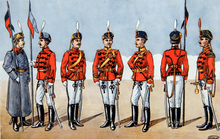Roșiori (military unit)
The Roșiori were a type of cavalry unit in the Romanian army. Active throughout the late 19th and early 20th centuries, the Roșiori were known for their vibrant red uniforms.
 1916 drawing of cavalrymen wearing the distinctive red uniform of the Roșiori | |
| Country | Kingdom of Romania |
|---|---|
| Role | Cavalry |
| Nickname(s) | "Red Hussars" |
History
The Roșiori were formed in the late 19th century during a period of modernization within the Romanian army. The result of these reforms was the formation of an irregular cavalry force (described in one source as being armed like Cossacks),[1] the Lakarashi, and a professional cavalry force, the Roșiori, who were armed and organized along the lines of the cavalry of the German Empire.[1] The Roșiori wore scarlet hussar uniforms, white pantaloons, and white belts;[1] some sources describe the units as the "Red Hussars".[1]
By 1908, the Romanian army had elected to split the army's professional cavalry forces into hussar and lancer regiments.[2] As part of this division, the Roșiori were re-organized as lancers, and formed six of the Romanian army's seventeen cavalry regiments.[2] The Roșiori were full-time soldiers, and maintained their distinctive red uniforms.[2] Roșiori regiments were made up of five squadrons (four of which were professional, one of which was irregular), with each squadron consisting of 174 horsemen.[3]
During World War I, the Roșiori regiments served with distinction in campaigns against Austria-Hungary, the Kingdom of Bulgaria, and the German Empire.[4] The conflict also saw the mobilization of dismounted Roșiori regiments.[5]
Following the Romania's joining of the Axis powers and subsequent entry into World War II, Roșiori regiments (which numbered 13 as of 1942)[5] saw service on the Eastern Front against the Red Army.[6][5]
List of Roșiori regiments
- 1st Roșiori regiment
- 2nd Roșiori regiment - Distinguished itself at the Battle of Prunaru, where it was nearly destroyed.[4]
- 3rd Roșiori regiment
- 4th Roșiori regiment - associated with the Romanian royal family, and ceremonially led by Queen Marie of Romania. Part of the elite 2nd Roșiori brigade during World War I.[4]
- 6th Roșiori regiment - reformed as the 6th Motorized regiment during World War II.
- 7th Roșiori regiment - alleged to have committed war crimes against the Jewish population of Bessarabia, Northern Bukovina, and Transnistria during the Holocaust. Postwar investigations of the unit were first begun and then later suppressed by the Communist government of Romania.[6]
- 8th Roșiori regiment
- 9th Roșiori regiment - part of the elite 2nd Roșiori brigade during World War I.[4]
- 10th Roșiori regiment
- 11th Roșiori regiment
- 12th Roșiori regiment
- 13th Roșiori regiment
References
- COOKE, William Smith (1876). The Ottoman Empire and Its Tributary States-excepting Egypt, with a Sketch of Greece. Compiled by Captain W. S. Cooke ... With Maps. W. Clowes&Son.
- The Twentieth Century. Nineteenth Century and After. 1908.
- Martin, Frederick; Keltie, Sir John Scott; Renwick, Isaac Parker Anderson; Epstein, Mortimer; Steinberg, Sigfrid Henry; Paxton, John; Hunter (Librarian), Brian; Turner, Barry (1908). The Statesman's Year-book. Palgrave.
- (in Romanian) Multiple authors. România în anii primului război mondial (Romania during the years of World War I) (Bucharest, 1987), Editura Militară.
- Pettibone, Charles D. (2012-01-16). The Organization and Order or Battle of Militaries in World War Ii: Volume Vii: Germany's and Imperial Japan's Allies & Puppet States. Trafford Publishing. ISBN 9781466903517.
- Popa, Ion (2018-01-02). "The 7th Roșiori (Cavalry) Regiment and the Holocaust in Romania and the Soviet Union". Dapim: Studies on the Holocaust. 32 (1): 38–56. doi:10.1080/23256249.2018.1432250. ISSN 2325-6249.